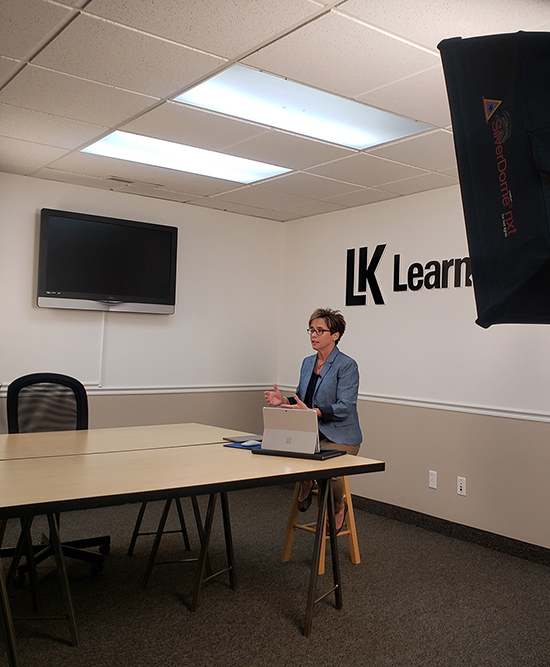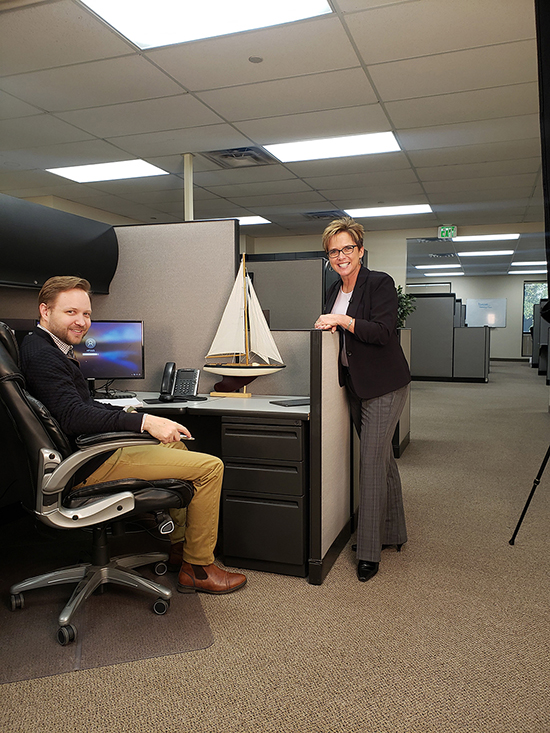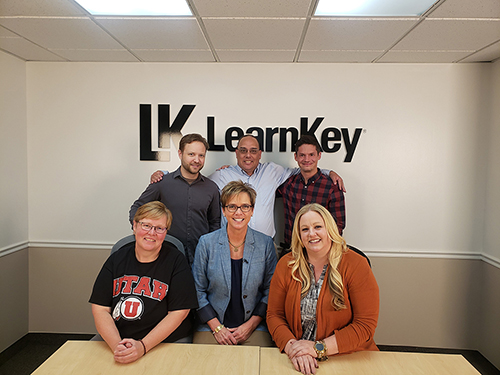
Author: Jason
ADJUSTING WITH THE TIMES: CHANGES TO LEARNKEY’S COURSES
Hello there. It’s been a while, but I’ve been deep in the think tank (with some help) for quite some time, looking for ways to improve our courses. And in doing so, I returned to one key principle about learning anything computer-related: practice makes perfect.
Our courses have video-based training, pre- and post-assessment tests for each domain, and practice labs. Most of our courses have a project workbook with exercises designed to help people achieve their course goals,, such as passing a certification exam and becoming more employable in their chosen field or fields of study.
But, as with many creations, we always look to improve the product. We have begun to roll out some enhancements to our courses to boost your learning experience. Some of the new features you will see in our newest courses are:

- Practice examples within each domain and many “try this yourself” exercises throughout the course. For example, the new version of the Python course includes several opportunities for immediate practice after a group of videos covering a topic. After you try to solve whatever problem is in front of you, the following video goes through the solution. These exercises give you great feedback while you are learning and will steer you toward areas where you can gain extra practice. We have also incorporated these exercises into the upcoming Adobe 2024 series of courses.
- For coding courses, code examples to complete. Occasionally, within a course, you will be presented with a code example that requires you to fill in some missing information. Again, the goal is to get you some extra practice and think beyond the video content to solve problems. These exercises will sharpen one’s test-taking skills.
- Faster updates to existing courses. Many courses have exam objectives that occasionally undergo minor updates (every 6 to 12 months). We are adding some small, text-based updates where necessary to keep these courses current. Many of these updates will have impromptu practice exercises right after those updates.

We are making other updates to our overall course presentations, but those are the three major features to expect at this time. As always, thank you for partnering with LearnKey for your learning and career aspirations.
Do Certifications Still Matter In a Post-Pandemic World?

In a word, yes. Though technology and markets have changed, and attitudes toward working at home vs. working in an office vs. working on an island with a satellite… OK, I’m getting carried away here, but certifications still matter. Our CEO, Jeff Coruccini, outlined this in a blog post at the beginning of the year, but let me add some statistics here about certifications themselves:
According to CompTIA, the certification body for A+, Network+, and Security+, three industry-leading certifications, 96 percent of human resource managers use IT certifications as part of the screening process for candidates. 96 percent; that’s 24 out of every 25 human resource managers. According to Coursera, 59 percent of cybersecurity jobs require at least one related certification.
But lest you think these percentages are limited to IT jobs, consider this. According to Indeed, 62 percent of those surveyed for QuickBooks positions indicated they got a higher starting salary because they obtained a QuickBooks certification. And let me share a personal anecdote. My first IT training full-time position was at a hospital. I had Microsoft Office Suite (MOS) certifications; those certifications put me at the high end of the starting salary range, a full 25% higher than if I had not obtained those certifications.
Certifications are more than proof that one has expertise in the certification earned. They also prove several characteristics that make for an outstanding employee:
- A willingness to learn, often in a very compact amount of time
- The ability to study and research
- The fortitude to finish a project from start to finish
- The ability to succeed on a task after not succeeding. In this context, that would mean retaking an exam if one does not pass on the first attempt (it happens to the best of us)
So, which IT certifications are most important for those starting an IT career? This article from Coursera lists the top 10 IT certifications in 2023, and we have courses for six of the top seven certifications on the list. If you are looking at an IT career path and have not started the journey of obtaining any certifications, consider this an invitation to do so. I’ll be rooting for your success down your chosen path.
Working With Teachers on Certification Prep
One of my favorite lines from a movie and something I can relate to is a scene from the movie 48 Hours, where a character named Luther goes to pick up his car in a parking garage. The attendant looks at the ticket and says, “Wow. Two years.” Luther’s response: “Yeah. I’ve been busy!”
That is how I feel about this blog, given all our major suites (Adobe, CompTIA, and Office) have either been upgraded or are being upgraded since the last time I said hello here. One other suite of certifications has changed, from the Microsoft Technology Associate (MTA) suite to the IT Specialist suite, now hosted by Certiport instead of Microsoft.
The changeover happened about a year ago, but the MTA program officially ended on June 30. To that end, many teachers who use our courses are trying to get certified in the IT Specialist certifications in time for the fall. And I have had the privilege of helping some teachers lately, specifically the Hillsborough County schools in Florida, prep for two of these certifications, Device Configuration and Management and HTML/CSS. I liked being in a live environment again, albeit virtual, as that is what I did primarily before joining LearnKey in 2015.
The time I spent with the teachers reminded me of some critical exam points, and I want to share two of them with you today. First, always get a copy of the objectives for any exam and study those well, paying close attention to each objective’s first word or phrase. There is a big difference between “Describe…” and “Configure…” as the latter indeed will have more in-depth questions on an exam.
Secondly, get hands-on practice where you can. For example, for the HTML/CSS exam, build some webpages using HTML and CSS. Make sure you have a code example for each objective on the exam. Make the website your own. Studying something always resonates better when you can make examples of your own.
Lastly, if you can study in a group, great; this way, you and the other group members can research together and bounce concepts off each other. Someone else may better understand an idea than you do and vice versa. We as a group did that by going through some practice exam questions, and the exercises benefited the teachers as they prepped for the exams.
We have some big course releases coming soon, which I will detail in this blog. And I promise not to be like Luther any longer.
2020-21 Career Pathways Update
Hello, everyone. At the beginning of each year we set internal goals and one of my goals is to set the course order and career pathways we will pursue the coming year. Inevitably, demands and priorities change, and so do exam objectives for courses we plan on filming seemingly right before filming, but I digress.
One adjustment we have had to make is to update career tracks to reflect the ever-evolving Microsoft certification transitions from fundamental certifications to role-based certifications. The theory behind this is that certifications are more valuable when tied to a certain job role rather than just a cursory knowledge of a system. Personally, I think it is a great idea as this allows for those pursuing certifications to better target the areas of expertise they want.
That said, one of the main reasons for this career pathways adjustment, besides the fact that cloud computing is growing rapidly, is that as of January 31, 2021, all fundamental exams are being retired. This includes all exams starting with 70- and all MB- exams (for Microsoft Dynamics) as well.
With that said, allow me to present to you the highlights of all the career pathway changes:
NEW: Cloud Administrator
- Exams: Azure Fundamentals (AZ-900), Azure Administrator (AZ-104), and Azure Security Engineer (AZ-500)
- This is replacing Windows Server 2012 MCSA (exams 70-410, 70-411, and 70-412)
- Reason: Microsoft is pushing Azure, its cloud infrastructure, heavily and the adoption rate is picking up speed
UPDATED: Programming
- Exams: Oracle Java Associate (1ZO-808), Flutter Certified Application Developer (AFD-200), and Azure Solutions Developer (AZ-204)
- These are replacing the soon-to-be-retired Microsoft programming exams (70-480, 70-483, and 70-486)
- This is a much “wider” track in that we have one general certification (Java), one for mobile app development (Flutter), and one for cloud (Azure)
NEW: Artificial Intelligence
- Exams: Azure Fundamentals (AZ-900), Azure AI Fundamentals (AI-900), and Designing and Implementing an Azure AI Solution (AI-100)
- According to LinkedIn, 133 million jobs will touch AI-enabled automation by 2022
NEW: Database Professional
- Exams: Azure Fundamentals (AZ-900), Azure Data Fundamentals (DP-900), and Designing and Implementing a Data Science Solution on Azure (DP-100)
- This is an excellent track for someone looking to become a data analyst
NEW: Advanced Database Professional
- Exams: Implementing an Azure Data Solution (DP-200), Designing an Azure Data Solution (DP-201), and Administering Relational Databases on Microsoft Azure (DP-300)
- This basically replaces the MCSA for SQL Server
The timeframe for these tracks is from now to about 12 months from now for all of these and, per usual in the IT business, these are subject to change. But this should give you an idea as to how we are evolving our offerings to match with the best possible employability scenarios for you as you pursue your journey.
You Have to Learn and Study Online. Now What?
Hello again. Before I dive into the subject of the title above, allow me to personally wish all of you the best of health physically, mentally, and emotionally during these trying times. I take encouragement in seeing all sorts of news stories about those out there helping their fellow humans as much as possible. I know when I go to the store, I’m saying an extra thank you to every employee I see.
On to our subject. Whether you’re a college student, high school student, or adult learner and whether you are learning through our courseware or some basic subject courseware, learning online and in at least some kind of isolation is far different than learning in a traditional classroom. Having taught in both situations the past 20 years, I have three observations/hints that will hopefully help with the online learning modality:
- Mix it up
Online learning has many facets. Sure, you have the video portion as the focal point of the course, but many of these online courses have other materials, like quizzes, textbooks, and, for computer programs, the programs themselves. Change up the learning mode frequently. Many of our courses have a suggested lesson plan/study guide in the back of our workbooks that break up the lessons into video, practice, and workbook time. Use those as your guide. Too long on one medium and you will start to wander. When you feel yourself needing to mix it up, do it. - Pace yourself
How long is a high school class session, typically? 45 minutes? 55 minutes? (It was 55 for me back in high school, I think. That was a long time ago.) Match each study session for each subject/course to that time. It is very difficult for anyone to be in learning mode for too long without a break. If you are not bound by time constraints, here is a good rule to follow: If you are starting to lose focus on what you are trying to learn, take a break. Get up, walk around, get a drink of water, do something. Now, you may be thinking, “but I study for 2-3 hours straight all the time.” Good for you if you can do that. But studying is different than learning. Studying, for the most part, is a reinforcement of that which you have learned. It takes much more intense concentration to learn something new and one’s attention span for that is usually smaller. If you don’t believe me, try learning something new (like cooking for me) for two hours straight and see how much you remember after the first 30-45 minutes. There are numerous articles online that will back this up and I invite you to research this if you wish. - Test yourself
As you mix up your learning and pace your learning, test yourself often. I don’t mean take a quiz or take a test here. I mean see if you can do that which you have learned, if applicable. Let me give you two examples: If you just finished watching a section of a Word course on how to build a table, open Word and build a table or two and put some data in there you can relate to. If you just finished watching a section on adding adjustment layers in Photoshop, open Photoshop, get a picture to edit, and make your own adjustments to the picture. Many of these certification exams are hands-on, meaning that you must perform tasks. What better way to get some practice than to create and edit a project that relates to something you like? Just to drive the point home, when I needed to refresh my Adobe Premiere skills before teaching the course last year, I edited some footage of something to which I can relate: my golf swing. If only I could edit the swing itself…
I digress. The point is: learning online is indeed different from learning in the classroom but, absent of a live instructor, you can make the rhythm of learning online make you feel as if you are in a classroom, through mixing up the learning, going at a reasonable pace, and testing yourself often through getting some hands-on practice.
How Important is Business Communication? Important Enough For a New Certification
About two months ago, I was having a conversation with our CEO and he said, “Brother (he calls me brother, how nice), wouldn’t it be nice if we could do a soft skills (meaning non-tech) course that could help improve communication skills for business? Is there a cert on that?”
At the time, the answer was yes, I could come up with a course but no, there was no official certification for this. But wouldn’t you know it: two weeks later, Certiport announced a new Communication Skills for Business (CSB) certification that will be out later this fall. Great minds think alike.
We, as you well know, are dedicated to improving employability every day. But that doesn’t just mean tech skills and being able to do a COUNTIFS function in Excel. Far from it. Strong employability requires strong communication skills, and this is where this course fits in to the overall employability umbrella.
Every so often we decide to change things up and bring in a guest author to do a course. For this course, we are very excited to have Jennifer Stubblefield, the reigning Certiport Educator of the Year, bring you this course. Jennifer has been a business teacher for over 25 years and is a champion Microsoft Office Master instructor as well. She understands both the tech side and the communication side of employment and it shows in this course.
We filmed the course last week and we are very excited to bring you this course. This course is like no other in that though the exam is heavily topic-based, our course is scenario-based and interactive while teaching to the core exam topics of
:
- Describe Basic Communication Principles
- Plan for Effective Communication
- Apply Best Practices for Creating Business Deliverables
- Deliver Your Message
- Receive Communications
- Analyze Communication Scenarios
This course applies to both those looking for jobs and those already in a career. I was going to say this course applies to those looking to improve communication skills, but let’s be real: everyone could use improvement in this area. And Jennifer covers this literally from head to toe (as in wardrobe for an interview – I knew a tie is supposed to come down to a belt buckle, but did you?). She also points out that whoever runs the front desk at a company is watching interview candidates from the moment they walk in and will divulge what is seen to the hiring decision-makers. A good reminder for all of us.
The truth is, we as a filming crew learned a lot even though improving our communication skills wasn’t on our minds when Jennifer arrived to film this course. For example, did you know there is a big difference in meaning between having a meeting in a L-shaped seating arrangement vs. sitting across from someone? I didn’t. Now, I do. I learned a lot about improving business communication skills just in the three days it took us to film this course. And I talk for a living. So, if I can learn a lot, so can you, no matter where you are on your career path
Let’s go CADDing – New Course, New Series
Hello and happy spring from your humble senior instructor. I am very happy to announce that we have released the first course in our new series of courses on Computer Aided Drafting and Design (CADD). The course? Autodesk Certified User for AutoCAD. For those of you who are wondering what exactly is AutoCAD, let me tell you: it is computer-aided design (CAD) software that architects, engineers, and construction professionals rely on to create precise 2D and 3D drawings (that’s the description from the official website, so let’s go with that). The course itself, which covers the material on the AutoCAD Certified User exam, takes one through building some lamp drawings for the inside of a house.
In fact, “house” is the major theme of this entire series. Our second course in the series, Autodesk Revit, centers around building a house. The major use of Revit is designing buildings, hence the house design. The third course in our series, Autodesk Inventor, focuses on mechanical drawings. Thus, in that course, you will see how mechanical parts of a house are built.
CADD as a whole is a growing need, with a 7% growth expected for demand in the job market in the next decade, according to the Department of Bureau and Labor Statistics. This series of courses will help increase your employability prospects for many areas of CADD. And, for the AutoCAD and Revit courses, we have brought in an expert: Gary Roberts, who has over 20 years’ experience teaching Autodesk and similar applications at the high school level. In fact, through his teaching, I can say with confidence that I can now draw the architecture piece for something besides a golf course. Just don’t ask me to draw a raindrop as I’ve been told that’s not my best drawing skill (get the Animate CC 2015 course and you can decide for yourself).
Microsoft Office 2019, Here We Come…
A belated Happy New Year to you all. January is over, so I can say that. As I sit here writing this wondering when winter will ever end, I am happy to let you all know that we are in the midst of building and producing our Office 2019 suite of courses. As we are always trying to improve our product and your employability prospects, here is what you can expect to see as these courses start to roll out this spring:
Word 2019 – building a resume, cover letter, schedule, and small brochure.
Excel 2019 – building a small budget, a schedule list, and multiple summaries of data.
PowerPoint 2019 – building recruiting presentations for a small business and a school club.
Outlook 2019 – the whole personal information management package, from email, to calendar, to contacts, to tasks, to notes, and how all are used for continuity in the business world.
Access 2019 – a database to manage a small business.
Oh, small business, yes, I almost forgot: all of these courses are going to revolve around scenario-based learning (here are part I and part II of the scenario-based learning blogs for your reading pleasure) as we cover most of the material through two avenues: day-to-day usage at a fictitious athletic club business, and practical scenarios for students and those looking for a new career, as outlined in some of the scenarios above. We are not only about helping you pass the Office 2019 MOS exams (yes, these courses will help you do so), but we are also about making learning fun, fast-paced, enjoyable, scenario-based, and, most importantly, there to improve your employability.
And, these courses are loaded with practical tips, brought to you by our new “face of LearnKey,” Marie, who is helping us bring you a rich, practical, and full learning experience not only for Office 2019, but for more of our future courses. We look forward to start bringing you this series later this spring. Until then, here’s to spring getting here. Now. At least pitchers and catchers start reporting this week. Hope springs eternal!
Analogies of a Mutt and a Semi-trailer
A few weeks ago, I was attending an online meeting when my phone rang. It was Scott Walker, one of our sales managers/fellow golfers in the company. He said, “You have a minute? I’m at a high school class and the kids want to say hello to you.” Having left my say-hello-to-students outfit at home, I asked if I was on camera. Scott said, no, just the phone. The next thing I know, I’m saying hello to a bunch of high school students who are taking our MTA Networking course and pursuing their MTA Networking certification (smart move for employability, by the way).
We only had a few minutes to chat, as they were reaching the end of their class, but they asked me a couple of quick questions about the networking career path in general. Then one student asked how I felt about a certain antimalware program. I said, “It’s better than nothing,” which drew some laughs (inferences being what they are, I suppose). I then added, “Look. If you put a small mutt dog out to guard your house, even if the dog doesn’t do anything, people will steer clear just because you have a dog there.” Message understood.
Fast forward the clock to today, when another sales manager/fellow golfer, Kelly Woods, asked me to talk to a student about a potential career change to programming. This gentleman was brand new to programming in general. He asked me how best to learn it and where he could apply it as a career. I said, “You work on semis, right? Well, programming has a similarity to that. Not every semi is the same, but once you work on a few you get the basics down and then it’s not too hard to learn about new ones and their nuances, right?” He said yes. I said, “There you go.” This left him with a better understanding of what he may encounter should he decide to pursue this path.
What’s my point here? There are two. First, analogies are great at taking something foreign and making it seem not so. Being able to learn using analogies improves employability, as it makes things easier to understand. I use those as much as I can when teaching. Second, one of the favorite parts of my job is connecting with students, both current and potential. It keeps me engaged with people as cameras and computer screens don’t talk back to me… at least not yet.
So, to Scott Huerkamp, the teacher from Niceville High School in Florida, thank you for allowing me to say hello to your class and talk to them for a few minutes. And, to the potential student who is thinking of moving from semis to programming, thank you and good luck with whatever you decide.
And, since I mentioned golf, I’ll leave you today with this: A friend of mine called me and complained about how he can’t put four good shots in a row together. My response: “That’s OK. You only hit one shot at a time.” Analogy? You decide.
Scenario-Based Learning – Part Two
Hi again. Yes, I know: two blogs for me in one week is a record or something. So was hitting every fairway but one the other day (accuracy in golf is not my strong suit, but, I digress.) A while back in this blog space, I detailed how we structure our courses around scenario-based learning and how, through scenarios, our courses not only help you get ready to pass certification exams but also give you strong employability skills in the fields in which you may be pursuing.
That was the past. Today, I want to talk present and future. First, the present. We have just put together a video further explaining the concept of scenario-based learning and its importance. You can watch it at the end of this blog.
Secondly, the future. Here is a list of courses (not complete, but a list) we are releasing over the next few months, and, to help you look forward to these, the scenarios tied to these courses:
| Course | Scenario |
|---|---|
| Word Expert (Exam 77-726) | Writing and formatting a term paper |
| Excel Expert (Exam 77-728) | Analyzing data from an international bike shop |
| Photoshop 2018 | Getting photos ready for a magazine |
| MTA Cloud Fundamentals (Exam 98-369) | A company thinking of moving part or all of their infrastructure to the cloud |
| ASP.NET MVC (Exam 70-486) | Building a robust website for a book store |
After all, as the video points out, in our courses, we not only give you the knowledge to complete a task, we give you a task to complete. And that, my friends, is the essence of scenario-based learning. Oh, yes, the video. Enjoy!


